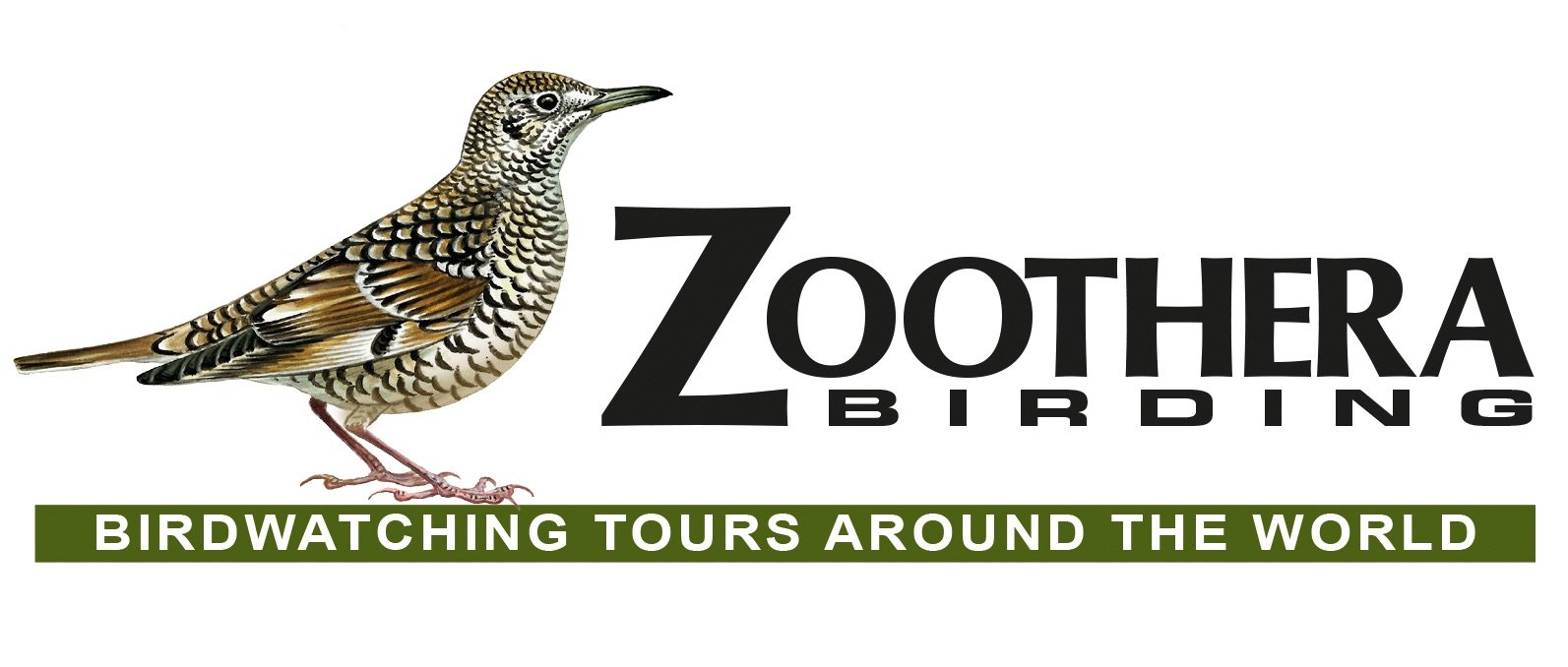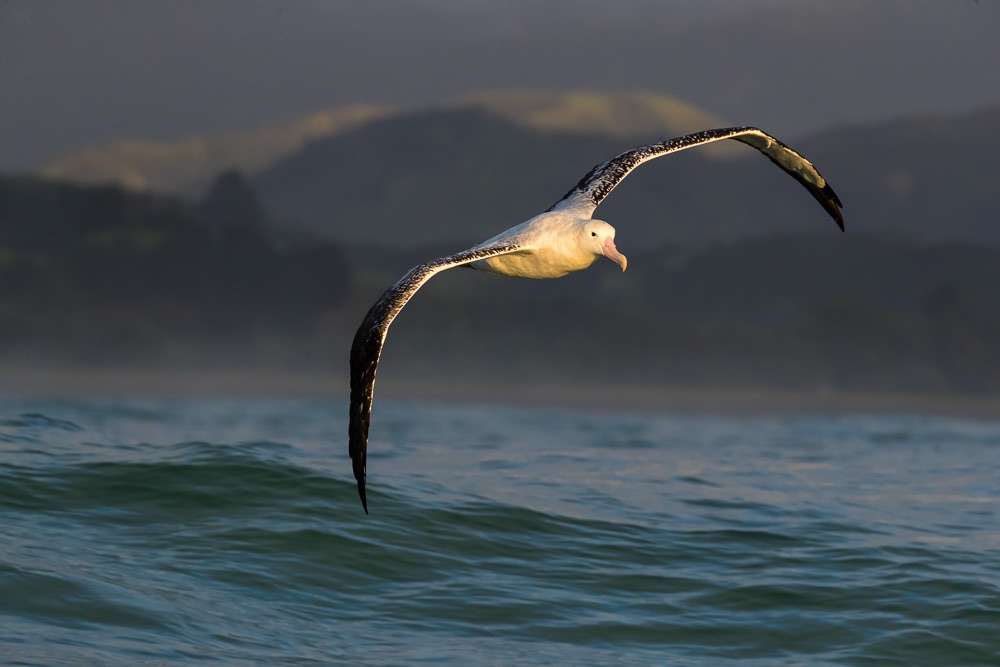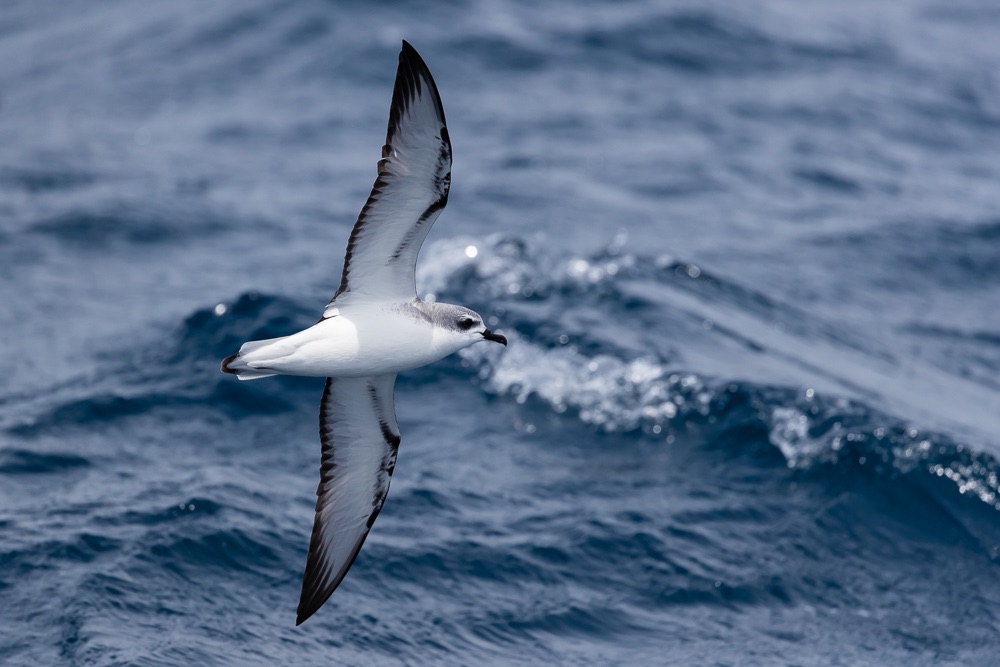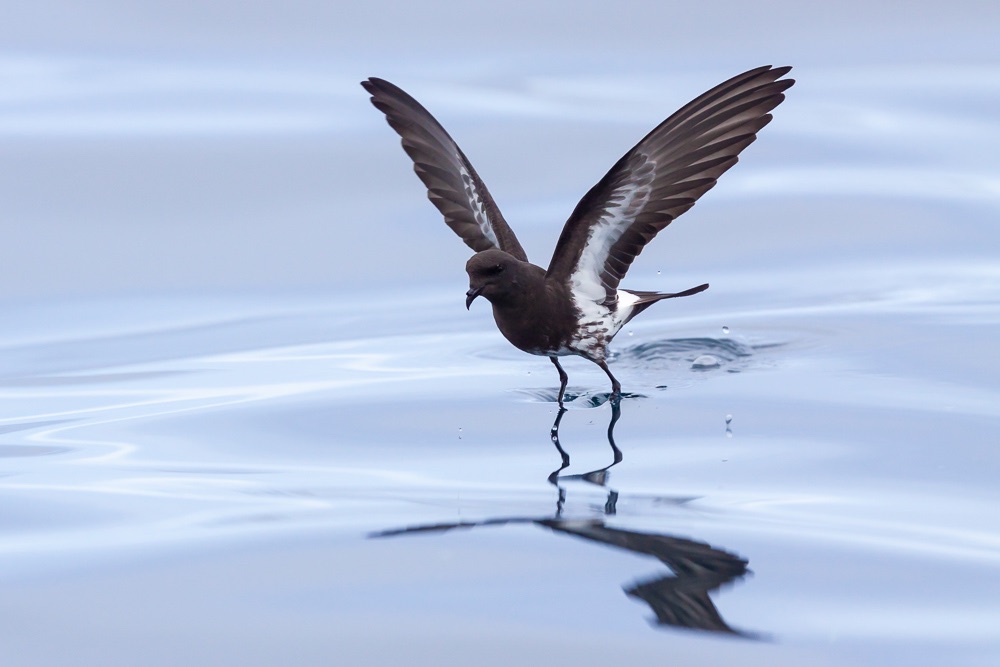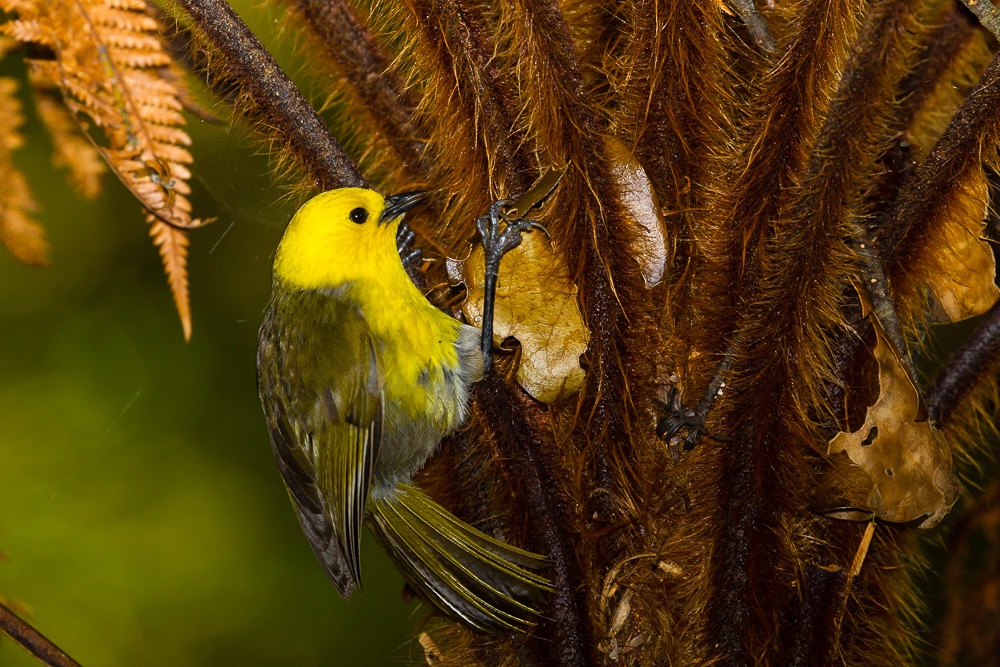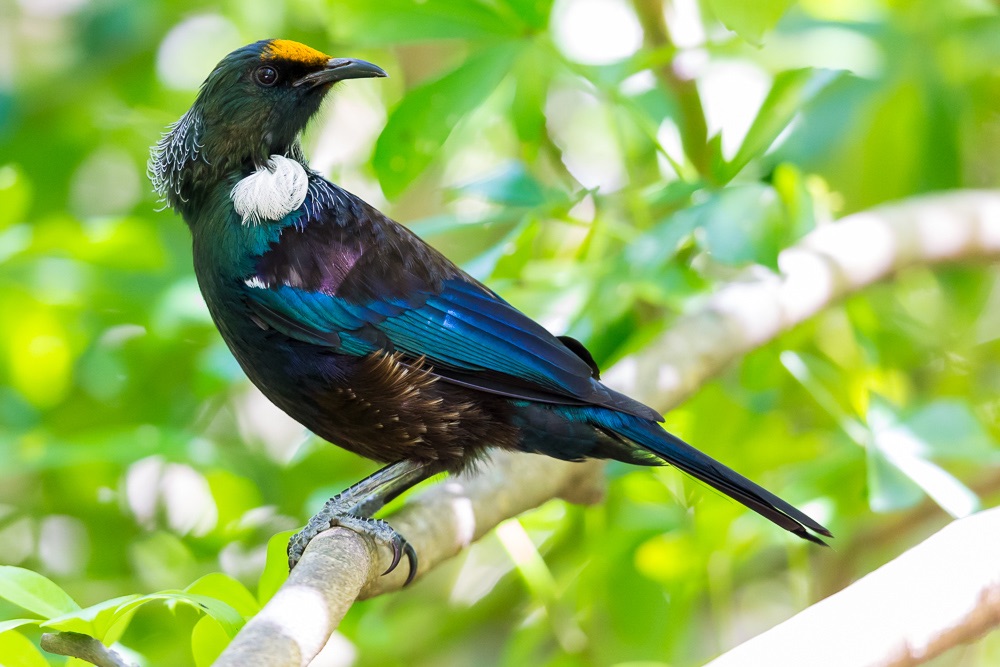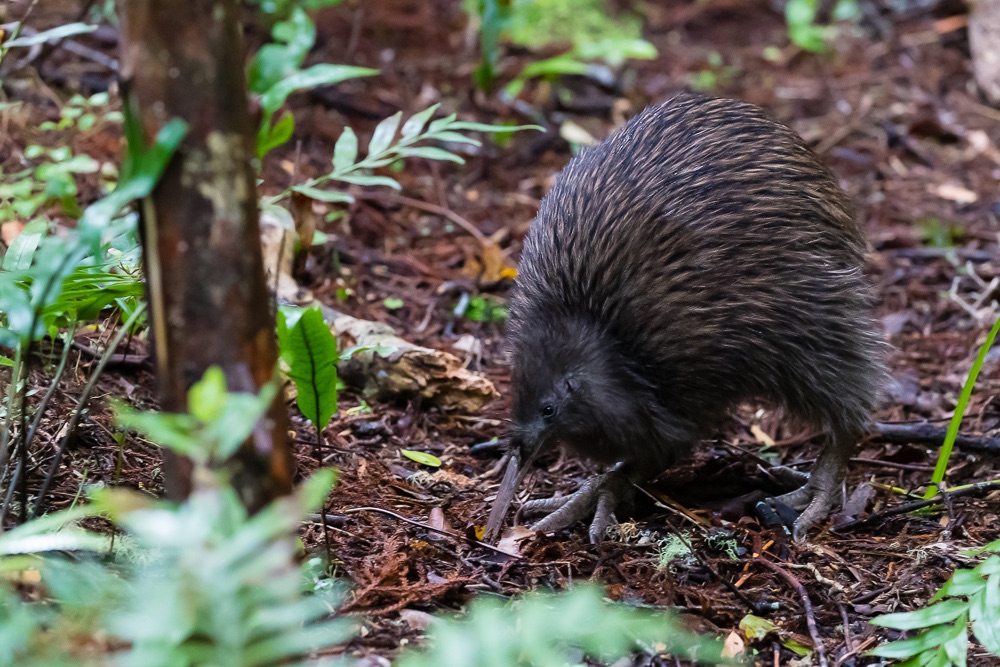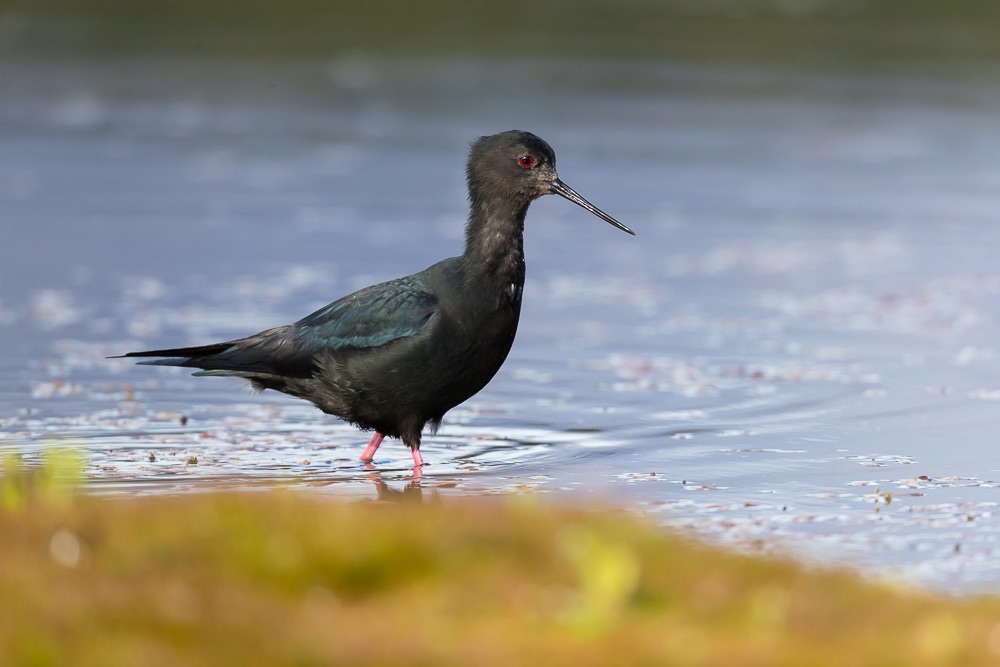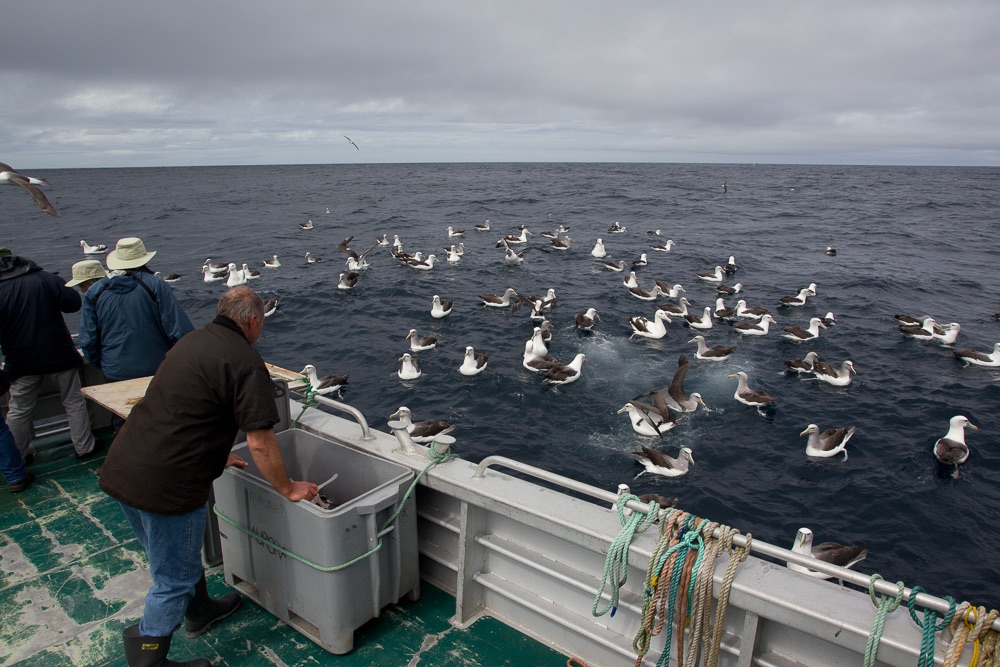NEW ZEALAND
Day 1 Arrival in Auckland - 14th Feb
This is purely an arrival day in Auckland.
Day 2 Auckland - Kerikeri
One of our first stops will be a forested area near to central Auckland where we will get an introduction to some of New Zealand’s forest species, such as North Island Tomtit, New Zealand Pigeon, Grey Fantail and Grey Gerygone (Grey Warbler). We will then head to a spot on the rugged west coast to one of New Zealand’s three mainland Australasian Gannet colonies. Superb views and photographic opportunities exist, and we will also look for other common coastal species such as Pied Cormorant, Red-billed Gull and White-fronted Tern. We will then head back across to the east coast to several wetland areas to look for New Zealand Scaup, New Zealand Grebe, Grey Teal, Australasian Shoveler, Pacific Black Duck (Grey Duck), Paradise Shelduck, and other waterbirds. We will also spend time looking for Buff-banded Rail (Banded Rail) in likely mangrove habitat.
Continuing northwards we are heading for Kerikeri where we will check into our accommodation and rest up for our post-dinner walk to look for Northern Brown Kiwi. We will certainly hear, and may see Morepork as well. Night in Kerikeri.
Day 3 Kerikeri to Warkworth
This morning we will head east to a small estuary which is one of the last places to see the critically endangered Fairy Tern (currently only about 30-40 birds), as well as other shorebirds, including New Zealand Plover (NZ Dotterel), Variable Oystercatcher, Black-winged Stilt (Pied Stilt) and Arctic migrants such as Bar-tailed Godwit and Red Knot. Several estuarine areas further south may also be checked depending on time and whether we have been successful in finding Fairy Tern. Other areas close by can be checked for New Zealand Pipit and Australasian Little Grebe before heading south to our accommodation in Warkworth, where we will stay for two nights.
Day 4 Hauraki Gulf Pelagic
Today we will spend the day out on the water in the beautiful Hauraki Gulf. Leaving from Sandspit we will head out towards Little Barrier Island and chum at several locations nearby. The main focus of the day will be to locate the seabirds which are most easily seen in the northern part of New Zealand, such as the recently rediscovered New Zealand Storm-Petrel, as well as Black and Cook’s Petrels, Buller’s, Flesh-footed, Fluttering and Little Shearwaters and White-faced Storm-Petrel. Depending on weather and conditions we may head out to a site where there is another Australasian Gannet colony, and during late summer a roosting site for Grey Ternlet (Blue Noddy). Eyes will not just be on the look-out for birds, as this area is also excellent marine mammal habitat with both Common and Bottle-nosed Dolphins being possible, and occasionally in late summer Bryde’s Whales. Night in Warkworth.
Day 5 Tiritiri Matangi Island
Today we will head to one of New Zealand’s most incredible birding locations. Tiritiri Matangi Island is truly a gem in New Zealand’s conservation crown. A short ferry ride out to the island should give us a chance to see Fluttering Shearwater, White-fronted Tern and possibly Parasitic Jaeger (Arctic Skua). Upon arrival we will be met and given information about the island by Department of Conservation staff. Once farmed, the island is now an open sanctuary that has been extensively replanted, with some areas of original forest remaining. We will focus on seeing all of the endemics on the island, with North Island Saddleback, Kokako, Stitchbird, Takahe, Brown Teal and Red-crowned Parakeet being present. Other more common forest birds such as Whitehead, Tui, Bellbird, New Zealand Fantail, Grey Gerygone and North Island Robin should be seen, and we will also wait for Spotless Crake to appear at one of the small ponds. After dinner we will head out to look for Morepork and hopefully Little Spotted Kiwi. Tuatara, an endemic reptile related to the dinosaurs, are also present on the island and we will spend time looking for these and probably bump into the odd Little Penguin as well.
The night will be spent in accommodation on the island, with this being limited to a communal bunkhouse with bunk beds in shared rooms. Although rustic the experience is well worth it and not to be missed. An overnight bag will be taken with minimal gear, bedding will be provided, but due to the shared nature of the accommodations remember some nightwear! Night at Tiritiri Matangi.
Day 6 Tiritiri Matangi Island - Miranda
Getting up early will allow us to hear the dawn chorus, and we will leave Tiritiri Matangi mid-morning, heading south to one of New Zealand’s premier shorebird sites, the world-renowned Miranda in the Firth of Thames. The Firth of Thames is listed under the Ramsar Convention as a wetland of International significance. We will check into our accommodation near Miranda, and then head to the Miranda Shorebird Centre to get information on the latest sightings and then head out to see what’s around for ourselves. We are likely to see Wrybill, Bar-tailed Godwit, Red Knot, Red-necked Stint, Ruddy Turnstone, New Zealand Plover, Banded Dotterel (Double-banded Plover), Variable and South Island Pied Oystercatcher, Black-winged Stilt, Black-billed Gull and Caspian Tern. During the summer months there are usually a few of the less common shorebirds that visit our shores, such as Sharp-tailed, Pectoral, Marsh, or Terek Sandpiper, and we will be on the look-out for these and other vagrants. Shorebird watching in this area is largely dependent on the tides, so we will be working around the high tide, and may visit other nearby areas if time permits.
Day 7 Miranda - Whitianga
For the early risers we will be up early to have another quick look at waders around Miranda, before we all head across the Coromandel Peninsula to Whitianga on the eastern side of the peninsula. The afternoon will be spent out on a pelagic, specifically to target Pycroft's Petrel which breeds on nearby islands, but it also gives us a second shot at all the northern breeding seabirds. We will expect to see Common Diving-Petrel, Buller’s, Flesh-footed and Little Shearwaters, Fairy Prions, Grey-faced, Cook’s and Black Petrels, and White-faced Storm-Petrel, with several species of albatross being a possibility. Whitianga is where the first sighting that sparked the rediscovery of the New Zealand storm-petrel was made back in January 2003, so who knows what we may see? We will aim to be back in port in the late evening, so that we have the opportunity to see Pycroft’s Petrels rafting up before heading into their breeding colonies in the evening. We will overnight in Whitianga.
Day 8 Whitianga - Turangi
We will head back across the Coromandel Peninsula making several quick stops including a stop en-route at a swamp to look for Australasian Bittern and other waterfowl. However, our main focus for the day is the Pureora Forest Park to the west of Lake Taupo. This extensive area of forest is one of the best places in the North Island to see New Zealand Kaka (North Island subsp.), Yellow-crowned Parakeet, Long-tailed Koel (Cuckoo), Shining Bronze-cuckoo, Rifleman, and we will also encounter other more common forest species. We will also be on the look-out for New Zealand Falcon which inhabits this area, and New Zealand Pipit may be seen on the roads in the area. We will head to Turangi in the early evening to our accommodation.
Day 9 Turangi to Napier
This morning we will concentrate our efforts around Turangi looking for our most extraordinary waterbird, the Blue Duck. Inhabiting swift-flowing mountain streams these birds have declined markedly, even at sites where they were reliable only a few years ago, and there are really only a handful of locations they can be seen without major hikes. We will visit several locations and spend time watching these remarkable birds.
We will then head east to a forested area between Taupo and Napier. As it is an intensively managed site where introduced mammals are controlled and fauna and flora have been able to flourish, we are likely to see more forest birds here than at other locations in the North Island. North Island Robin, Kokako and North Island Kaka have been reintroduced, and we should at least have a chance of seeing these, as well as New Zealand Pigeon, Long-tailed Koel (Cuckoo), Shining Bronze-Cuckoo, Whitehead, Tomtit, Tui, Bellbird and Rifleman. New Zealand Falcon and New Zealand Fernbird are also in the area and we can spend time trying to locate both of these species.
We will then head down to Napier, where if time allows we will check out an estuarine area for shorebirds, or several wetland areas for waterfowl and other species. Accommodation for the night will either be in Napier or nearby Havelock North.
Day 10 Napier/Havelock North - Foxton
The focus for the morning will depend a little on what we have or haven’t seen to date. There are locations for shorebirds, waterfowl and Australasian Bittern, and we can have a second go at forest species where we were the day before, or we can take it easy and head slowly across to the Manawatu region and head to the Manawatu Estuary for more views of Wrybill and other shorebirds.
We will stay the night in Foxton, very close to the Manawatu Estuary, which is one of the best sites in New Zealand for shorebird watching. Shorebirds at this location are often extremely confiding, and we will see Bar-tailed Godwit, Red Knot, Variable Oystercatcher and probably Wrybill. Depending on the state of the tide, and what’s around at the time, other birds like Pacific Golden Plover, Sharp-tailed or Curlew Sandpipers, Ruddy Turnstone and Red-necked Stint may be present. Night in Foxton.
Day 11 Foxton - Picton
Depending on tide times we will call into the Manawatu Estuary again. We will then head south along the scenic Kapiti Coast towards Wellington, making several stops on the way to see Black-fronted Dotterel and waterfowl.
The Interisland ferry leaves from Wellington, heading across to the South Island via the Cook Strait. From the relatively stable platform of the ferry, this is an excellent piece of water to look for seabirds, with approximately half of the three hour trip spent in open water in the Cook Strait. Spotted Shag, Fairy Prion, Fluttering Shearwater and White-fronted Tern should be seen, and depending on weather conditions and prevailing winds New Zealand Wandering, White-capped and Salvin’s Albatross, Northern Giant-Petrel, Westland Petrel and Sooty Shearwater are all possible. Common Diving-Petrel and Little Penguin are often seen near the entrance to the Marlborough Sounds, and the latter often in the calmer enclosed waters of the Sounds. Less common seabirds are often seen within this stretch of water, as are dolphins, so it is well worth being on the lookout. The ferry docks in Picton, and we have less than a 5-minute drive to our accommodation in Picton.
Day 12 Picton - Kaikoura
Today we head out onto the Marlborough Sounds, further exploring Queen Charlotte Sound. Our main target for the morning is the New Zealand King Shag, a rare endemic with a population of only about 650 birds. We will also be looking for two dolphin species, the endangered endemic Hector’s Dolphin, and the more common Dusky Dolphin, as well as Little Penguin, Fluttering Shearwater, Spotted Shag and Australasian Gannet. New Zealand Fur Seals are also present.
We have the opportunity to make stops at two small island sanctuaries, where we will try for Orange-fronted Parakeet, South Island Saddleback, South Island Robin, and other common forest species such as New Zealand Pigeon and Bellbird.
Back in Picton at midday, we will grab some lunch and then head south towards Kaikoura, stopping to eat along the way, and then visiting a coastal area to search for shorebirds. There are generally Banded Dotterel, Black-winged Stilt, Black-billed Gulls, and sometimes other vagrant shorebirds. A brief stop on the scenic coast just before Kaikoura will allow excellent views of New Zealand Fur Seals and Spotted Shags, and enable us to ‘forecast’ sea conditions for the following days’ pelagic trip. If time allows we will check the surrounding areas for the introduced Cirl Bunting, and after dinner can head out to look for the introduced Little Owl in neighbouring farmland.
We will spend the night in the once sleepy, but now bustling town of Kaikoura, where we will have two nights in the same accommodation.
Day 13 Kaikoura
Today will be spent doing one of the great New Zealand pelagics. Due to the depth of the Kaikoura canyon just offshore, we are able to be in water 4,000 m deep within half an hour, allowing us to really get amongst the seabirds and although the species list varies throughout the year, in any season we can expect to have at least 3 species of albatross, normally as close as 5-6 feet away, including Northern and Southern Royal, New Zealand Wandering, Black-browed, Campbell, White-capped and Salvin’s Albatross. On top of this add Cape Petrel (Pigeon), Westland and White-chinned Petrels, Northern Giant-Petrel and the endemic Hutton’s Shearwater, which breeds in the spectacular mountains behind Kaikoura, plus the potential for other species like Grey-faced Petrel, Southern Giant-Petrel, Sooty and Short-tailed Shearwaters, and you have the makings of a truly memorable morning. The area is also renowned for Dusky and Hector’s Dolphins, and we may see these along the way.
The afternoon will be at your leisure, with time for a range of optional excursions such as doing another afternoon pelagic, whale watching (Sperm Whales are present year round), swimming with dolphins, or just relaxing and enjoying the scenery. We will stay at the same accommodation as the night before in Kaikoura.
Day 14 Kaikoura - Arthur’s Pass
Today we will head deep into the Southern Alps through to Arthur’s Pass, making several stops along the way and passing through some exceptionally scenic alpine areas. Our target bird for the day will be Kea, which we should be able to find near Arthur’s Pass itself. On the way we will make short stops to break up the journey including a stop at an estuarine area where we will look for shorebirds and terns. We may be lucky enough to find what is almost certainly one of the most beautiful terns, the Black-fronted Tern, which breeds nearby.
We should also catch up with some of the South Islands’ forest species, such as New Zealand Brown Creeper, Yellow-fronted Parakeets and South Island Robin, before checking in to our accommodation near Arthur’s Pass. After dinner we will venture out in the evening to try and listen for Great Spotted Kiwi, which are occasionally heard nearby.
Day 15 Arthur’s Pass - Franz Josef
This morning we will head west, up and over the Pass and on to the stunning West Coast. Our days’ events will be dictated by our previous successes, and we can head to forested areas to look for some of the South Island endemics, such as New Zealand Brown Creeper, look for New Zealand Fernbird (South Island subsp.) and Weka. We can search other alpine areas to look for Kea again, and enjoy the views, as well as making numerous stops to take photos. Nearing our destination town of Franz Josef we can head into the glacial valley to admire views of the Franz Josef glacier, or head out to the coast to see Great Egret and Royal Spoonbill in coastal lagoons. As we will be out late tonight we will try and be at our accommodation around late afternoon for a rest.
Our accommodation is on the outskirts of Franz Josef township, and after dinner we will head out to look for Okarito Brown Kiwi, the rarest of the three brown kiwi, with an estimated 400 birds remaining.
Day 16 Franz Josef - Wanaka
Depending on how late we were out the previous night, we will head south towards the township of Haast, stopping at one or two places on the way. During October-November, Fiordland Crested Penguins breed at sites along this coast and we should be able to get decent views of them. From Haast we head inland through some spectacular mountain scenery, with our focus being a visit to Haast Pass. This site is home to a number of forest species and has in the past had the endangered Yellowhead. However, more recently the species has been very hard to find here, with the population struggling to hold its own against introduced predators. However, the site is also good for New Zealand Kaka (South Island subsp.), Yellow-crowned Parakeet, Rifleman, South Island Tomtit, New Zealand Brown Creeper, and Long- tailed Koel (Cuckoo). We will stay as long as we can in this area, making the most of our time in this amazing forest before driving through to the beautiful lake-side town of Wanaka, just over an hour away, to our accommodation.
Day 17 Wanaka - Te Anau
Today will involve quite a bit of driving, but we will be passing through some of New Zealand’s most spectacular scenery, heading towards Milford Sound. We will pass through likely areas for Kea, Yellow-crowned Parakeet, Rifleman, South Island Robin, Tomtit and Long-tailed Koel (Cuckoo). Our focus however, will be to make a stop in alpine habitat for Rock Wren (South Island Wren), one of the World’s most primitive passerines and related to the more common Rifleman. The days stops will largely be dictated by weather and success with Rock Wren, which is not possible anywhere else along the way. Although the day will be spent in stunning scenery anyway, if time allows we may head through to Milford Sound to view it from the shore. We will spend the night at accommodation in Te Anau.
Day 18 Te Anau - Stewart Island
Today we are heading for the third main island of New Zealand – Stewart Island. We aim to catch the ferry from Bluff to Stewart Island late morning. There are options for stopping along the way, but it is likely we will head straight through to Bluff to meet the ferry. The van will stay in a secure carpark in Bluff, and we will board the ferry as foot passengers, with an overnight bag and the things we need for our two nights on Stewart Island.
Depending on the sea and weather conditions the one-hour ferry crossing can be excellent for seabirds, with Southern Royal, White-capped and Salvin’s Albatross, Giant-Petrels, Mottled Petrel, Cape Petrel (Pigeon), Common Diving-Petrel, Fairy Prion, Sooty Shearwater and Brown Skua all possible. We will also see Foveaux Shag, either as we leave Bluff or on arriving at Stewart Island. Upon arriving we will check into our accommodation, and should be able to see New Zealand Kaka (South Island subsp.), New Zealand Pigeon, and Tui around the township of Oban, before heading to the nearby Ulva Island via water taxi.
Ulva Island is another predator free sanctuary, but home to some of the South Island specialties we may still need. Yellowhead, South Island Saddleback, and some of the more common forest species such as Brown Creeper, Red and Yellow-crowned Parakeets, Kaka and Rifleman can all be found here. Back in Oban we will have dinner, after which we will head out to search for Southern Brown Kiwi, which promises to be an unforgettable experience.
Day 19 Stewart Island pelagic
Today we plan to do a pelagic, but this is one part of the world you don’t want to be caught out by weather. Therefore, we will head out to see what we can find, but the distance and direction of travel will depend entirely on the weather. However, if we hit it right, the results can be stunning. With such a close proximity to the Southern Ocean and large seabird colonies being on many of the surrounding islands we may be able to find an excellent array of seabirds. In particular target birds for the day are Fiordland Crested Penguin, Yellow-eyed Penguin, Southern Royal Albatross, White-capped and Salvin’s Albatross, both Northern and Southern Giant-Petrel, Mottled and Cook’s Petrel, Broad-billed and Fairy Prions and Common Diving-Petrel. Other more common species we will almost certainly see are Cape Petrel (Pigeon), Sooty Shearwater, Spotted and Foveaux Shags, Brown Skua, White-fronted Tern and Red-billed Gull. Almost any vagrant Southern Ocean seabirds are possible and we will be keeping our eyes peeled for storm-petrels and other albatross and petrel species.
Depending on our success with Southern Brown Kiwi the previous night, and the possibility of cancellation due to weather, we may head out again after dark as a back-up. Our accommodation will be the same as last night.
Day 20 Stewart Island - Oamaru
We will leave fantastic Stewart Island on the morning ferry, hoping to catch up with a few more seabirds as we head to Bluff. We will then head northwards towards Oamaru, taking in the very scenic Catlins Coast. This coastal section is renowned for its scenic views and rough weather-beaten coastline. During a stop at one of the beaches along the way we will search for Hooker’s Sealion (a New Zealand endemic) which are often found on this section of coastline. We can also stop off at several other places en-route to admire the scenery and look for forest birds. We will also stop at a beach to look for Yellow-eyed Penguins coming ashore. Depending on the weather and prevailing winds, seabirds may also be passing along the coast, with species such as giant-petrels and Otago Shag being possible. Our accommodation for the night is in Oamaru.
Day 21 Oamaru - Twizel
We again head inland, this time into one of the driest parts of the South Island – the arid Mackenzie basin. With stunning glacial till-coloured lakes, mountains and red tussocks, the scenery and birds will be amazing. The focus of the day is the worlds’ rarest shorebird - the Black Stilt. With a population of around 100 wild birds, they are a species which has a considerable conservation effort invested in them. Depending on our luck, we may find them easily at our first stop, or they may make us work for it. Along the way we will be keeping eyes peeled for New Zealand Falcon, which is regularly found in this area, as well as stops for the introduced Chukar, and waterbirds, including Great Crested Grebe, Common Coot and the ever difficult Baillon’s Crake (Marsh Crake). On a clear day we should have views of New Zealand’s highest mountain, Mount Cook (Aorangi). We will spend the night at accommodation in Twizel.
Day 22 Twizel to Christchurch - 7th March
Heading northwards towards Christchurch we will head through an area of agricultural country before hitting the coast and crossing a large number of braided rivers that flow from the majestic Southern Alps to the sea. Many of these rivers are good breeding sites for Wrybill and Black-fronted Terns, and we may makes stops here or at several coastal lagoons before arriving in Christchurch.
We will end the tour at the International Airport in Christchurch around 1pm. If departing from the airport we recommend not booking any flight before 3:30pm to allow enough time. If staying in Christchurch for just one night, we suggest hotels adjacent to the Airport.
All photos copyright Brent Stephenson
Top row: Wandering Albatross, Pycroft's Petrel, New Zealand Storm Petrel
Middle row: Yellowhead, Tui, Stitchbird
Bottom row: Southern Brown Kiwi, Black Stilt, Kaikoura pelagic
